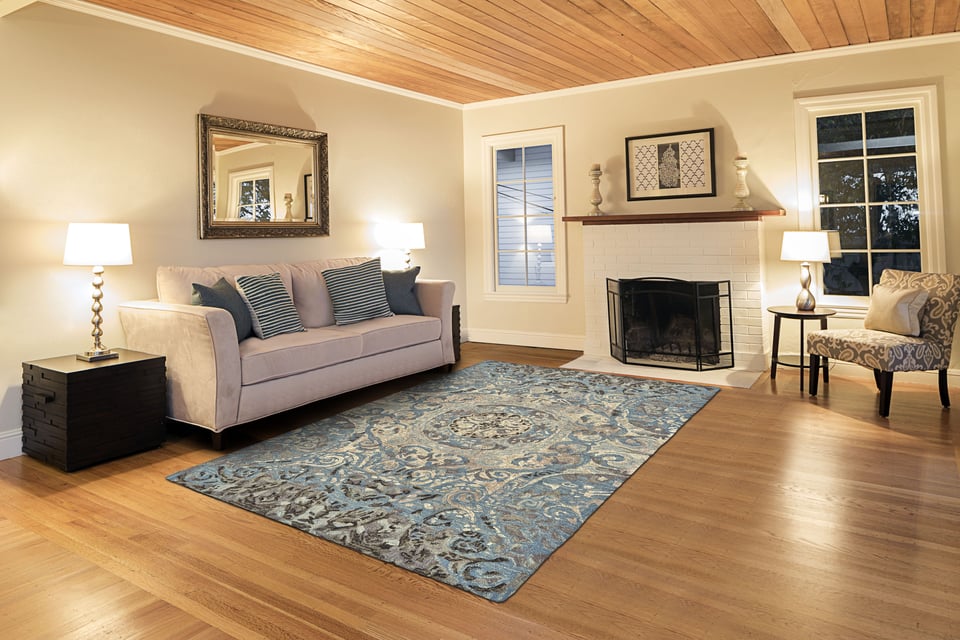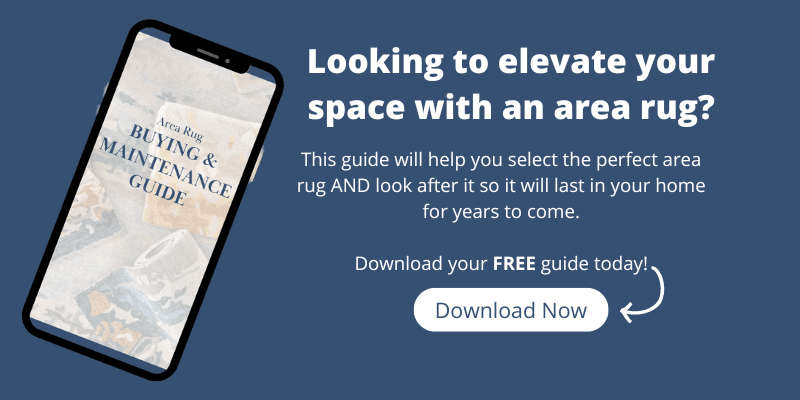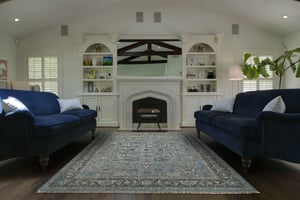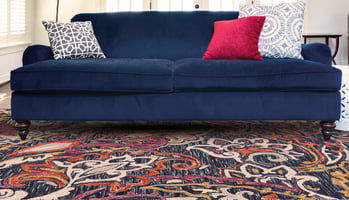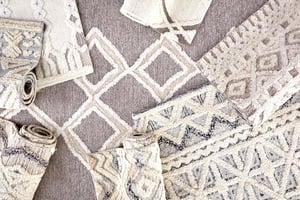Area rugs can really bring an entire look together and create cohesion in your space. You know that...
What Goes Into the Cost of an Area Rug?
Area rugs serve many purposes in the home. They’re functional, they help with comfort, and they’re often a piece of art, too! But for something so versatile, the price can be tough to predict because of all the elements at play.
The frustrating thing is that area rugs drastically vary in price. For example, the rug manufacturer Feizy offers 8’x10’ area rugs that cost anywhere between $500, all the way to $25,000 (sometimes even more)!
There are certainly bargains out there, but if you’re looking for a long-lasting, heirloom potential, detailed, high-quality area rug, you’re definitely looking at a higher price point.
With all of these options and different prices, it begs the question, “What goes into the cost of an area rug?”
At McElhernan’s Furniture + Design, we specialize in high-quality furniture and offer complimentary design services. In addition to that, we have a comprehensive Rug Gallery with hundreds of samples for you to touch, see, and even borrow at no obligation. We’ve helped many customers over the years find the perfect area rug for their homes. And along the way, we’ve absolutely had to field a few questions around cost and the determining factors.
We’ve found that there are three main factors that dictate the cost of an area rug:
With the help of our Design Guides, we’ll get right into it below so you can have a better understanding of why area rugs cost as much as they do!
The 3 factors that affect the cost of an area rug
1. Material
Listed from most expensive to least, the following fibres are most commonly used in the construction of area rugs.
Silk
This is a fibre of luxury that adds a beautiful sheen to an area rug. Silk is also very strong and holds dye well, giving you a vibrant pattern (if you so choose). Although a strong material, it’s not exactly the most durable, so a silk rug may be better suited in a low-traffic area or even hung on a wall as more of an art piece.
Wool
Both soft and durable, wool is commonly used in high-quality rugs. It’s naturally water repellent and stain-resistant. Wool offers a certain warmth and coziness, too, and can hold itself well in higher traffic parts of your home, like a living room.
Cotton
Cotton is a rather versatile, cost-effective natural material. It’s not as “built-to-last” as other fibres and can fade over time, but it is much easier to clean and look after. Because of that, cotton rugs can be placed in more casual areas, like bathrooms or a kid’s bedroom.
Jute
Jute rugs instantly add a natural feel to your space. Jute is environmentally friendly, durable, and dense. A jute rug is great on its own, but its natural, earthy tones make it a viable option for layering, too. If you have a more valuable, intricately woven, colourful rug, feel free to layer it over top to add more dimension and texture to your space.
Viscose
At first glance, you may mistake a viscose rug for a silk one. As a semi-synthetic type of rayon, viscose offers a cheaper - but still convincing – option to a more luxurious material. Similar to its fancier sister, silk, viscose isn’t the most durable. So, be wary of that when you’re thinking about rug placement in your home.
Synthetics
Synthetic fibres are man-made materials like nylon, polyester, and polypropylene. Less eco-friendly, yes, but rugs with these fibres are often cheaper because of mass production. If you’re on the hunt for a rug that you can use outdoors, synthetic rugs are the more weather-proof choice.
Rug manufacturers, such as Feizy, have also introduced PET (polyethylene terephthalate) fibres to create new rugs. PET is a form of polyester that is made from recycled plastic and is 100% recyclable. PET rugs are extremely durable and the fibres are more environmentally friendly than other synthetics.
Blends
It is quite common to find any one of these fibres used in a blend. Blends can decrease the price considerably and allow you to fashion a rug that suits your needs based on the strengths of the different materials coming together.
2. Method of construction
Handmade
You’re not just buying a rug when it’s handmade - you’re buying a piece of art. The people knotting and weaving your rugs are disciplined in their craft and put a lot of care and attention toward creating your desired look. There’s a built-in value and uniqueness with a handmade area rug.
The intricacy of the pattern will increase labour time, too, since much more attention to detail is required.
This brings about another factor in cost; in relation to construction: ethical labour practices.
There’s been a global effort to improve conditions for workers, which includes fair pay and the implementation of child labour laws. Labour costs have increased to ensure better working conditions.
There are two main types of handmade construction with area rugs: hand-knotted and handwoven/hand tufted.
- Hand-knotted
Hand-knotting is a delicate art that is extremely labour intensive and time-consuming. A rug that is completely hand-knotted from start to finish can take MONTHS to make. Like, anywhere between four to seven months – even more depending on the size of the rug.
Knots per square inch are generally looked at to determine the quality and cost of an area rug. So, the more knots equal better quality (and more money).
One of our Design Guides, Shelley, points out that once a customer realizes the painstaking hours that go into knotting just a square inch of a rug, they’re much more understanding when they see the higher price points.
- Handwoven/hand tufted

This type of construction is somewhere in the middle between handmade and machine production. A hand-woven rug is made by punching strands into a canvas with the help of a tool. The finished look is usually flatter than that of a traditional hand-knotted rug. Hand-weaving a rug still requires time, but this method is not as labour intensive.
Machine-made
Most definitely a faster method of production, many rugs and carpets are made by machine operated looms. The quality of the material doesn’t have to suffer - you can still find machine-made wool rugs - but a certain artistic magic and personality are lost with a machine. In the interest of getting your rug faster and saving on labour costs, machine-made rugs are a reasonable option.
Printed rugs are another machine-made type of rug construction. This method is a little newer to the game and just screams 21st century.
A printed rug is created by taking a plain rug (think blank canvas) and literally printing colour and pattern onto it. The result is a flat woven rug, with a great pattern at a low price point. However, because the design is printed onto the surface and not woven in, the pattern is prone to fade over time.
If you’d like a pop of colour in your home and don’t mind replacing your rug more often than you would if it was handmade, printed rugs could definitely work for you.
3. Size
Well, this is an easy one to explain.
Basically, the bigger the area rug, the more it will cost you because more materials and time are required. An 8’ x 10’ rug is almost always more expensive than a 5’ x 8’ rug of similar quality.
And even if you’re thinking, “Oh, I’m only making it longer by a foot, it shouldn’t change things too much.” Actually, it does! You’re changing the whole square footage of the area rug.
It’s kind of like a pizza in that sense (bear with me here, I do have a point). When you go from a medium pizza to a large, there’s only a couple of inches difference between the two. But now with the large, you’re getting a few more pieces, and you go from feeding a small family to a much bigger one!
And just like with area rugs, the bigger the pizza, the more it will cost.
What area rug should I get?
Taking the three factors that influence the cost, now you can come up with that perfect rug that will fit within your price point!
If the quality of material in a rug is your priority, perhaps you can compromise on the construction method to level out the price.
Or maybe size is the most important thing to you and you’re wondering: “What Size Should My Area Rug Be in My Living Room?” Once you determine that, then you can explore your construction and material options to get an idea of the cost.
And, of course, you want your rug to look good and work with your home, too! Feel free to check out our Rug Gallery at McElheran’s Furniture + Design. Visit us and take home one of our hundreds of rug samples, at no obligation, to see how it fits into your space.


